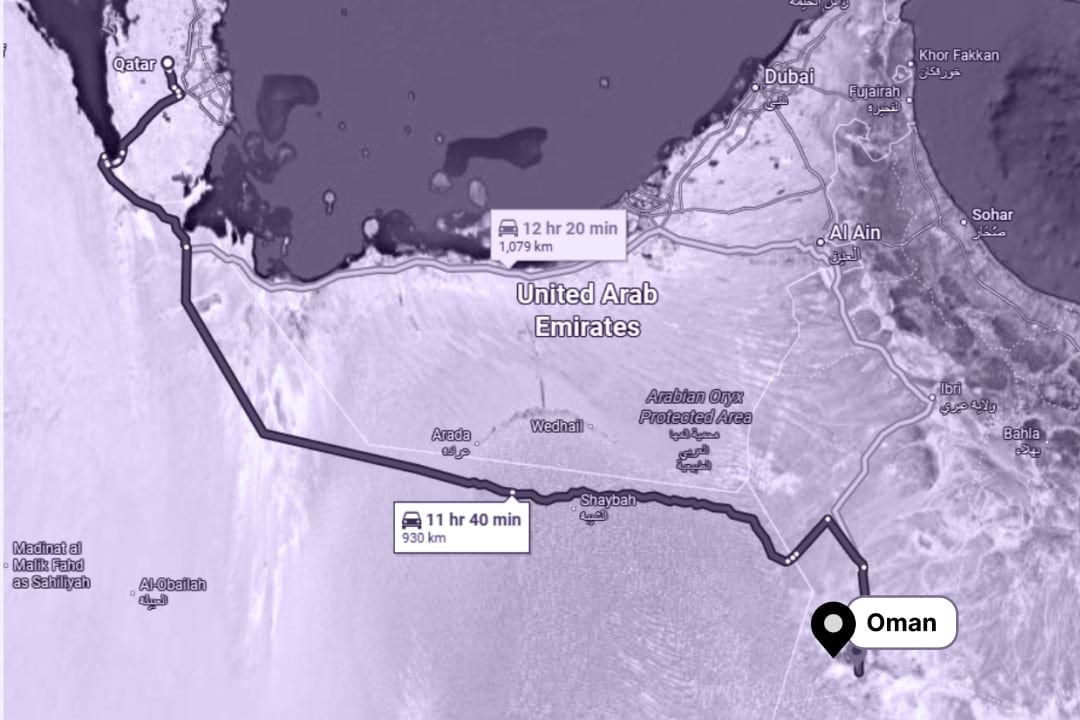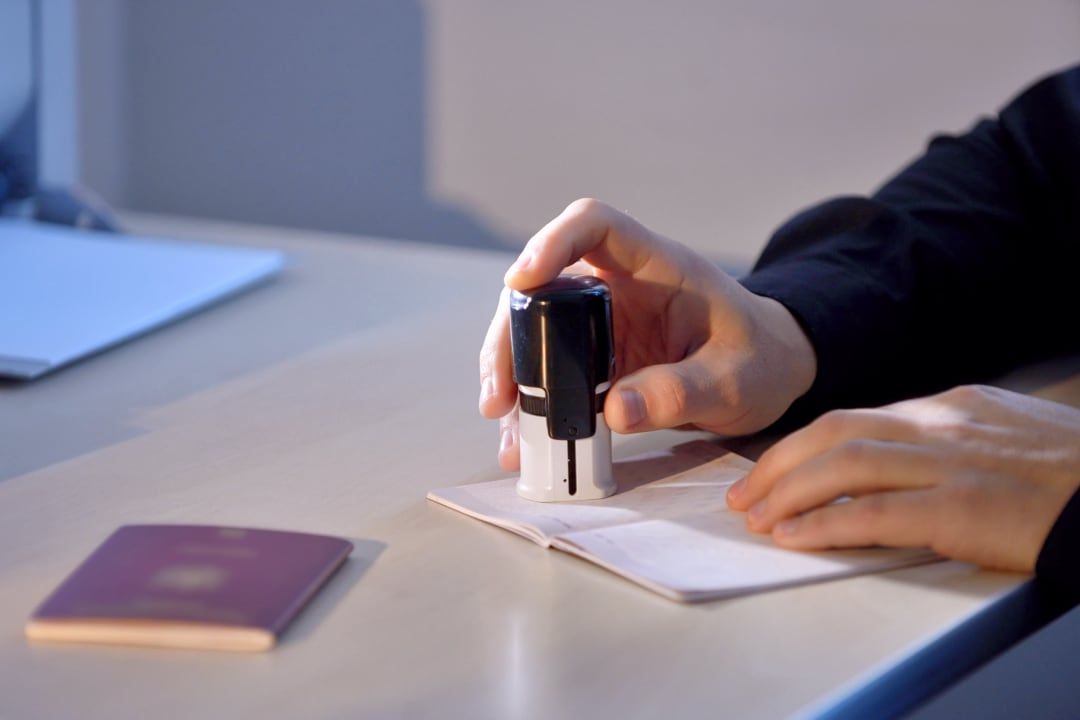Contents
Driving from Qatar to Oman is one of the Gulf’s most memorable journeys. Oman offers something rare in the region — raw, untouched, and contrasting landscapes. Think mountain villages, turquoise lakes on the trail to Wadi Shab, traditional souqs in Muscat, and day trips around the Daymaniyat Islands. It’s a long trip, but with a bit of preparation, it becomes less of a chore and more of an adventure.
Route and travel time

The road time from Qatar to Oman varies due to waiting times at border crossings. The distance from Doha to Muscat is over 1,000 km and typically takes 12-14 hours. Immigration and customs can add extra time, so plan your schedule accordingly.
Families with children often break the journey into two days, stopping overnight in the UAE and then proceeding to Oman. If you drive straight through, leave early in the morning to avoid reaching border posts late at night.
Do you need a visa for Oman?
Qataris and other GCC nationals can enter Oman without a visa, provided they have a passport valid for at least 6 months and ID.
Expatriate residents of Qatar must apply for a visa. This is easy to do, but requirements vary by nationality. Always check the latest guidelines for your passport on the Royal Oman Police website.
If you do require a visa, there are two options:
-
Apply online in advance through the Oman eVisa portal. There’s even an official step-by-step video guide
-
Get a visa on arrival at many land border posts. This option is available for specific nationalities and usually costs about QAR 48 (5 OMR)
Documents and requirements by country |
|||
|---|---|---|---|
|
Country |
Entry/Exit requirements |
Vehicle requirements |
Estimated cost |
|
Qatar (exit) |
Passport + Qatar ID |
Istimara registration, driving licence |
Usually none |
|
Saudi Arabia (entry/exit) |
Passport, passport-size photo with white background, health insurance (often bundled with e-visa), transit, or tourist visa for non-GCC nationals. GCC nationals are exempt from applying for Saudi visa |
Valid insurance for Saudi (can be also bought at Abu Samra border), vehicle registration, driving licence |
Around QAR 97 or more for transit/stopover visa depending on nationality |
|
UAE (entry/exit) |
Passport, Qatar ID + visa (e-visa, visa on arrival, or entry permit — depending on nationality) |
UAE-valid insurance, registration, driving licence |
Short transit/visit visa QAR 36–182 |
|
Oman (entry) |
Passport + Oman visa (e-visa or visa on arrival depending on nationality) |
Insurance covering Oman, registration, driving licence |
Visa on arrival — QAR 48. UAE exit fee — QAR 35. Border insurance, if required — QAR 105+ |
How the border crossings work

The road from Qatar to Oman is a string of checkpoints. Each has its own regulations and it helps to know the sequence and what to expect.
1. Abu Samra border: Qatar → Saudi Arabia
Abu Samra border is Qatar's main land gateway to Saudi Arabia. At Abu Samra, you'll present your passport, Qatar ID, and vehicle registration — Istimara. Customs may ask for insurance papers, and sometimes they conduct a quick vehicle check — including lights, tyres, and the extinguisher. Once your documents are stamped, you can proceed to Saudi Arabia.
2. Saudi Arabia entry
Here you'll go through immigration again. Non-GCC residents typically require a transit visa so ensure this is arranged in advance. If your Qatari car insurance doesn’t cover driving in Saudi Arabia, you’ll need to purchase Saudi border insurance at the checkpoint.. Officers may check your car for safety equipment, and they may also ask about your destination. Once cleared, you can drive on the Saudi highways — watch for speed cameras and plan your refueling stops carefully, as towns can be located many kilometers apart.
3. Saudi Arabia exit: Into UAE
Passports are stamped, and vehicle documents are checked again. This is a faster process, but queues can still form, particularly during weekends or holidays.
4. UAE entry
Present your passport again and provide a visa or entry permit. Depending on nationality, some travelers are eligible for a visa on arrival, while others must apply in advance. Officials will also check that your insurance is valid in the UAE. If not, you can buy temporary UAE insurance on the spot. Customs sometimes ask for a quick car inspection or to see a "No Objection Certificate" if you're driving a rental car.
5. UAE exit: Towards Oman
Before you leave the UAE, you'll pay an exit fee — about QAR 35. The process is straightforward — your passport is stamped, a fee is collected, and you're cleared to continue.
6. Oman entry
The final stage is entering Oman. Immigration officers will issue your Oman visa on arrival — typically around QAR 48 for most residents. Some nationalities must apply online in advance. You'll also need insurance covering Oman — if your current policy doesn't include it, temporary coverage can be purchased at the border, starting at QAR 105. Officials may inspect your vehicle's basic safety kit, which typically includes a warning triangle, spare tire, and first aid kit.
Costs to expect on the road
Fuel is one of the easier parts of the journey. A typical family SUV, like a Hyundai Tucson or Toyota Land Cruiser, will get you 10-12L/100km. So, you'll use about 110-130L each way for the 1,070km drive. At today's pump prices in Qatar — approximately QAR 2/L — that's around QAR 230-250 one-way, or QAR 500 round-trip.
You'll also need to budget for visas, cross-border insurance, and some spending for rest stops. Oman uses the Omani rial, and it's handy to know that the exchange rate of the Omani rial to the Qatar rial is 1 to 9.5. It’s good to have some local cash ready for smaller expenses.
Useful tips for smooth travel

-
Get cross-border car insurance: Many domestic insurance policies don't cover GCC travel. QIC car insurance can help you assess needed coverage or add-ons
-
Avoid late-night border crossings: Some checkpoints close at night or operate at a slower pace. Plan to cross early in the day
-
Plan for fuel, rest stops, and supplies: Carry water, snacks, basic tools, and first aid. Fuel stations may be less frequent on specific stretches — refueling before leaving towns is wise
-
Familiarize yourself with local traffic rules: Driving laws in Oman, such as speed limits and signs may differ — get to know the traffic laws before you go
-
Check rental car restrictions: Drivers with rental cars should check in advance if they are allowed to cross the border with them and whether the vehicles are properly insured for that. Rules for this differ between agencies that offer car rentals in Qatar
FAQ
Do I need an international driving permit (IDP) to drive in Oman if my licence is in a language without Arabic script?
Are mobile phones allowed while driving in Oman? What are the penalties?
Can I bring a pet by road when entering Oman — from Qatar or via the UAE?
How much time should I allocate for border checks on this route?








